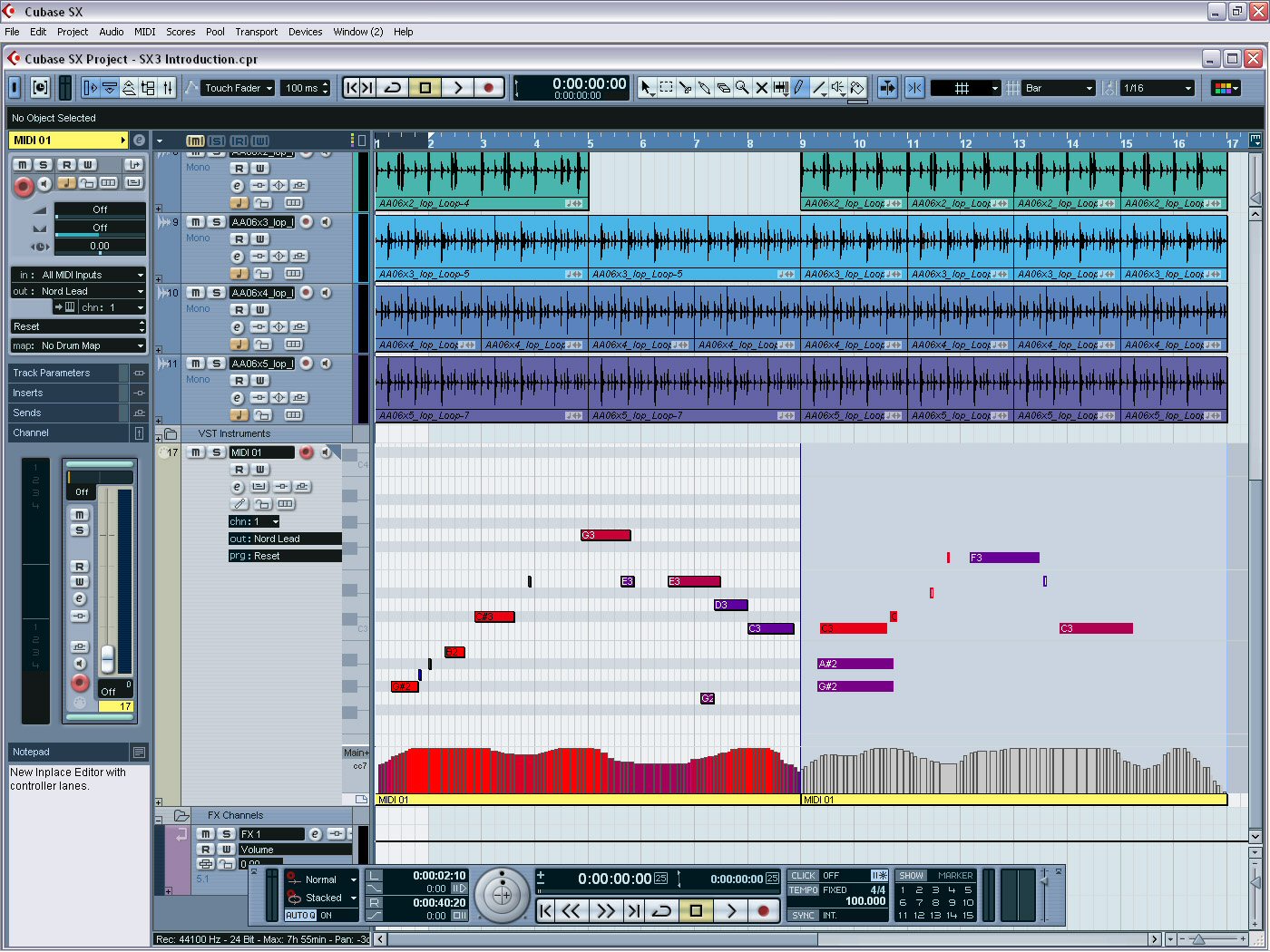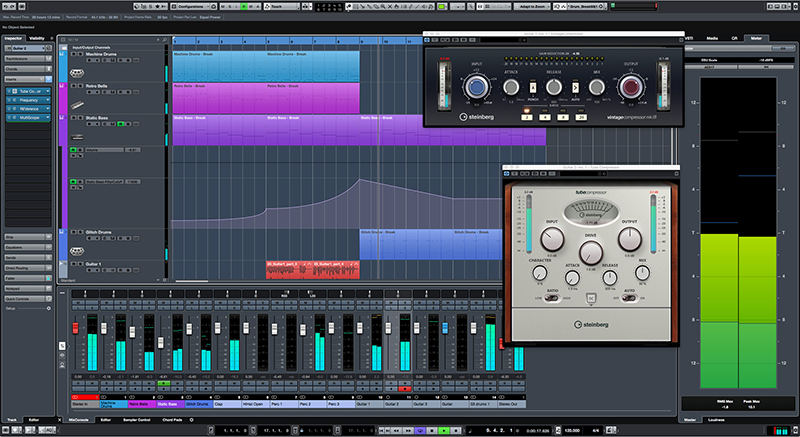We’d like to update you on the development and certification process regarding macOS High Sierra 10.13 for current Steinberg software products. For newer products, check the corresponding product p. Cubase is a digital audio workstation (DAW) developed by Steinberg for music and MIDI recording, arranging and editing. The first version, which was originally only a MIDI sequencer and ran on the Atari ST computer, was released in 1989. Cut-down versions of Cubase are included with almost all Yamaha audio and MIDI hardware, as well as hardware from other manufacturers.
PC and Mac versions compared, with a rundown of new features
By Tweak
Cubase continues on with its tradition of fine sequencers with SX3. Feature wise, and in many other categories, Cubase is the leader in sequencer technology, followed by Logic and Sonar in many important areas. Don't get me wrong here. It does not mean Cubase is the 'best' sequencer available. All the main sequencers today are rich in features and have been for a long time. What Cubase has going for it, in my opinion, is the ability to break new ground, develop innovative code that allows us new abilities to make our music and enjoy the process. Am I impressed? You bet. Now that they fixed some of the most troublesome issues with the release of 3.02, I am quite happy with it.
Cubase retains its glory as the most graphically rich sequencer. The interface is absolutely stunning and offers many way for a user to change the way it looks at you while you are working on a song. And if you don't like it, you can edit the look more extensively than any other sequencer, even down to the colors of the peak meters. Also, Cubase SX3 continues to bring in new features and replace those lost in the transition from Cubase VST to SX. Now that's all water under the bridge, and its time to enjoy cubase SX maturing capabilities.
New Features in Cubase SX 3
|
Lets talk a bit about the new features in Cubase SX.
Audio Warp Cubase's audio editor is quite interesting, particularly for those who like to manipulate audio. Years ahead of cakewalk and logic with its process history.. And now, even sophisticated stand alone editors like Sound Forge, Peak, and Apples new Soundtrack Pro cannot touch audio warp. Its also incredibly easy to use. You just open an audio file, set some hit points and drag their markers and you can speedup, slow down, to the granular level if you want. And it can all be done in real-time, that is, while the file is playing. There is no tweak-preview-tweak-preview as in other editors, You just tweak, see and hear the results right as you move the mouse. I have got to say, the Cubase audio editor is the best there is among all the sequencers I have tried. Sonar doesn't have a full-fledged editor. Logic's is umm 'vintage' and still can't render effects.
Intuitive Play order. This feature is a dream for arrangers. Slice up your song into verses, chorus, breaks, and reorder them easily to find out the most effective order. In other sequencers you have to rearrange all the blocks on the screen, and re-arrange them back if you don't like your new order. Here you can experiment all day till you find the best arrangement, and if you can't find one, your original is still there.
Inplace editor. The inplace editor happens right on the arrangement screen within the lanes of each track. its great for fixing a note when you don't want to open up one of the other editors. Its a great feature, that I first saw about in Tracktion. Not a critical feature, (you are only a double click away from the more powerful Key (piano roll) Editor) but a nice one.
MIDI device Maps. I tried for an afternoon to get some of these setup in Cubase SX 3.0.0 and found it incredibly buggy. I have not yet tried in 3.02. The idea here is to build devices (knobs, faders, controllers) that are tailored to the midi instruments you have. Every time you call up the instrument on a track the devices are there waiting for you. Its a minor nicety as there are plenty of other ways to get controller data on your tracks. I am also finding the MIDI device manager much easier to work with. Script building seems easier now. (The trick is to build the patchname script in Excel then cut an paste to a Text file). The application boots much faster now. Cubase SX 1.0 would crawl through MIDI device initialization. Those with a large MIDI rig will definitely see the improvement.


User definable workspaces-- A big improvement here. You can setup your screen(s) and save the workspace, then recall them from a menu. I really like that these are in a menu and can be organized. I think SX3 has finally caught up to logic's screenset idea and taken it one step further.
There's more new features, You can see the 'official' top ten new features over on the left. like an improved track freeze which lets you freeze with or without inserts on both audio tracks and VSTi's. This is helpful because you can still mess with processors after the track is frozen, which can save a bit of time.
PC or Mac OSX?
Cubase Sx3 For Mac Pro
Steinberg has the only full featured cross platform sequencer solution right now. On a PC SX is blazing fast and with the 3.02 update applied, its stability is good. It almost feels too fast. With my own setup using an emu 1820M it works well. Emulator X, which can be a touchy software sampler, also works well with no glitches. My experience was not as good using the earlier emu 1.6 drivers in 3.00 as a bug in emulator X would 'poof' Cubase but the Emu 1.7 drivers appears to solve it.
Regarding the look of the program, I like Cubase SX on OSX a little better. This may have nothing to do with Cubase itself, but with OSX, where the dialog boxes, menus, scroll bars, etc, all work in the standard Mac way. Also for some reason colors seem more vibrant in OSX even using the same monitors i use for the PC. But that's where the favorable comparison ends for me. I find its overall performance slightly less robust on my Mac G5 (dual) 1.8 as on my AMD 3400+. I am now running SX3 3.02 under Mac OS 10.4.2 (Tiger). There is considerable graphic improvement over 10.3x, which could get really slow. The pain is gone now, but its still graphically slower than on a PC. Though i have not used Cubase enough to compare performance with LogicPro, my impression is they are about the same, performance wise. Also, compared to Logic Pro, you'll notice all your VST and VSTi's are back at work. There's no audio units here and no audio unit evaluator watching over your plugs.
In the balance, my opinion is that Cubase SX is better on a PC, but not by much. Not enough to dissuade a die hard Mac user not to use it.
Now that the application is at 3.02, its way safe to upgrade. And worth it, in my ever humble opinion.


May your music shine
Tweak
July 2005
Want to discuss? Go to the Cubase topic at studio-central
Go to the Next Class
Go to the Previous Class
Cubase Sx3 For Mac Os




